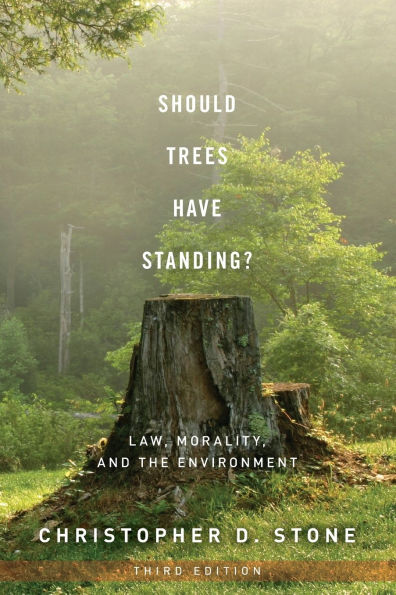Table of Contents
Introduction xi
Chapter 1 Should Trees Have Standing?: Toward Legal, Rights Fob Natural Objects 1
I Introduction: The Unthinkable 1
II Toward Rights for the Environment 3
III The Legal-Operational Aspects 4
(1) What It Means to Be a Holder of Legal Rights 4
(2) The Rightlessness of Natural Objects at Common Law 5
(3) Toward Having Standing in Its Own Right 8
(4) Toward Recognition of Its Own Injuries 13
(5) Toward Being a Beneficiary in Its Own Right 16
(6) Toward Rights in Substance 17
(7) Do We Really Have to Put It That Way? 22
IV The Psychic and Socio-Psychic Aspects 23
Chapter 2 Does the Climate Have Standing? 33
I The Climate as Client 33
II The Law of Standing: An Overview 35
(1) Duty Owing and Zone of Interests 37
(2) Injury in Fact 38
(3) Causation 42
(4) Redressability 43
III Standing to Force Disclosures 44
IV Standing's Many Fronts 49
(1) Ordinary Standing for "Ordinary" Economic Injury 50
(2) Rights-Based Claims 51
(3) Executive Standing in International Affairs 53
(4) Citizens' Standing to Force the Executive's Hand in Foreign Affairs 54
(5) Citizens' Standing to Force the Executive's Hand in Domestic Affairs 55
(6) Standing by a Designated Trustee 57
(7) Citizens' Standing to Force the Trustee's Hand 57
(8) Citizens' Standing without Statutory Basis (Public Trust Doctrine) 59
(9) Standing of Noncitizens 60
V Suits in the Name of Natural Objects 61
(1) Existing Law 61
(2) Could Standing for Nonhumans Be Expanded? 62
(3) Would Expanded Standing in the Name of Nonhumans Make Any Difference? 64
(4) Filing Suits on Behalf of Nature Is a Better Fit with the Real Grievances 65
(5) Suits on Behalf of Nature Are Better Suited to Moral Development 65
(6) Is Legal Representation on Behalf of Animals and Nature Really Feasible? 66
(7) The Advantages of Special, Statutorily Provided Guardians and Trustees 66
(8) The Guardian Approach May Be Superior to the Alternative Standing Strategies from the Perspective of Subsequent Preclusion Doctrines 68
(9) Advance Warning: The "Canary in the Mine" Rationale 68
(10) Protecting Third-Party Interests in Negotiations and Settlements 69
VI So, Where Do We Stand on Climate Change? 70
(1) Why Has Progress Seemed So Slow? 70
(2) What Role Could Climate-Related Litigation Play? 74
Chapter 3 Agriculture and the Environment: Challenges for the New Millennium 79
I Background 79
(1) The Historical Impact of Agriculture 79
(2) Aquaculture 80
II The Challenges 81
(1) Feeding Humanity 81
(2) Making Farmland Sustainable 82
(3) Reducing Agriculture's Environmentally Damaging Spillover Effects 82
(4) Tempering Conscription of the Nonagricultural Landscape 82
(5) The Promises and Threats of Technology 83
III Some Proposed Responses 84
(1) Sustaining Farmland 84
(2) Off-Farm Damage 85
(3) Reducing Pressure to Conscript the Nonagricultural Landscape 85
(4) Responding to Technological Innovation 87
(5) Conclusion 88
Chapter 4 Can the Oceans be Harbored? 89
I A Four-Step Plan for the Twenty-First Century 89
(1) The Fishing Sector 89
(a) The Fundamental Model: What Is Going Wrong? 90
(b) Step 1: Eliminate or Reduce Harvest-Increasing Subsidies 92
(c) Step 2: Improve and Extend Resource Management 93
(d) Step 3: Charge for Use 93
(e) Step 4: An Oceanic Trust, Fund 95
II Nonfishing Extraction Sectors 96
III Ocean Inputs 97
IV A Guardian for the Oceans 100
V Conclusion 101
Chapter 5 Should We Establish A Guardian for Future Generations? 103
I Background: The Maltese Proposal 103
(1) Are Future Persons Really Voiceless? 103
(2) For Whom (or What) Should a Guardian Speak? 104
(3) Are the Moral Arguments Disparaging the Rights of Future Generations Critical to the Guardianship Proposal? 105
(4) Which "Future Generation" Is the Guardian's Principal? 106
(5) Who Should Serve as Guardian? 106
(6) Where Should a Guardian Be Situated? 107
(7) What Official Functions Should the Guardian Serve? 108
(8) What Should Be the Guardian's Objectives? 109
(a) Resource-Regarding Standards 109
(b) Utility-Regarding Standards 110
(c) Efficient Level of Harm and Harm-Avoidance 110
(d) Precaution Against Selected Calamities and Safeguarding Specific Assets 111
(e) Avoiding "Irreversible Harm" 112
II Conclusion 112
Chapter 6 Reflections on "Sustainable Development" 115
I The Underlying Geopolitical Strains 116
II What Are Our Obligations to the Future? 117
(1) Sustainable Development as a Welfare-Transfer Constraint 118
(2) Sustainable Development as Preservationism 121
(3) The Rights of the Living 123
Chapter 7 How To Heal the Planet 125
I Introduction 125
(1) Invasion of Territories 128
(2) Who Is Responsible? 129
(3) A Voice for the Environment: Global Commons Guardians 130
(4) A Case for Seals 132
(5) Financing the Repair: The Global Commons Trust Fund 134
(6) Implementing a Global Commons Trust Fund 134
(7) The Oceans 135
(8) The Atmosphere 135
(9) Space 135
(10) Biodiversity 136
(11) Areas in Need of the Global Commons Trust Fund 137
II Conclusion 138
Chapter 8 Is Environmentalism Dead? 141
I Introduction 141
II What Movement, Exactly, Is Faltering, and What Should Our Expectations Be? 143
III Indicators of Success and Failure 144
(1) Indices of Public Knowledge: Environmental Literacy 145
(2) Indicesof Attitudes and Preferences 146
(3) Indices of Willingness to Contribute to Environmental Groups 147
(4) Indices of Environmentally-Sensitized Individual Action 147
(5) Indices of Influence on Lawmaking 149
(6) Public Sector Funding 151
(7) Litigation 151
(8) Indices of Miscellaneous Actions 152
(9) Actual (Direct) Indicators of Environmental Health 152
(10) Efficient Pollution 153
IV Self-Presentation 154
(1) Alarmism 155
(2) Image 155
V Conclusion 156
Epilogue 159
Notes 177
Index 237






